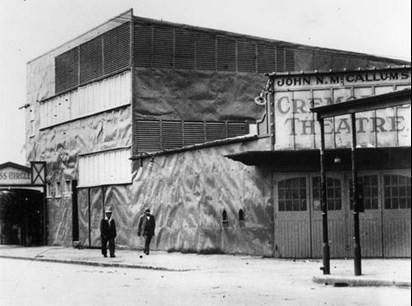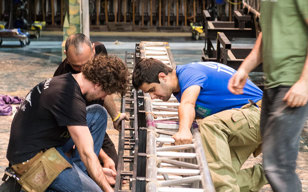QPAC is a place where audiences and artists come together to connect, learn, share stories and celebrate.
The proud home of live performance in Queensland for almost 40 years, Queensland Performing Arts Centre (QPAC), welcomes more than 1.5 million visitors to over 1,200 performances annually. We aim to deliver performances that engage our audiences and take them to a place of pure joy, connection or understanding. These shared experiences help us to better understand the world around us and contribute to building a more resilient and inclusive community.
As a venue, we provide an inspiring and welcoming environment for audiences, artists and presenting companies. As a producer, we broaden the choice of live performance available to audiences through creative development and investment in new productions and the presentation or co-presentation of a diverse range of local, national and international artists and companies. As an investor, we collaborate with commercial producers on national and international tours and nurtures emerging artists through pathways to professional development.
We are committed to excellence in live performance and cultural thinking to help sustain and grow our vibrant arts community. Our Reflect Reconciliation Action Plan (RAP) seeks to further a deeper connection with First Nations peoples of Queensland through leadership and development, both in our business and programming.
Located in a thriving cultural and educational precinct at South Bank that encompasses the Queensland Cultural Centre, QPAC is a Statutory Body of the Queensland Government with its responsibilities set out in the Queensland Performing Arts Trust Act 1977. QPAC is governed by a Board of Trustees appointed by the Queensland Government and managed by an Executive Group responsible for the operations and the achievement of the Centre's strategic priorities.
History
The south bank of the Brisbane River was a gathering place long before the building of QPAC. Traditionally home to the Yuggera and Turrbal people, the areas surrounding the southern bank of Brisbane River were originally known as 'Kurilpa' (place of water rats). Upon European settlement, the area became home to the infamous Moreton Bay Penal colony. Later it became home to free settlers and squatters. South Bank's wharves were the busiest in Brisbane, bringing an ever changing and ethnically diverse population to the area. By the mid 1800's, South Bank was Brisbane's hub of culture and trading activity.
The Theatre Tradition
South Bank has been home to many of the Brisbane’s theatres. The city’s first entertainment space, Croft’s Amphitheatre, opened in 1847 in Russell Street, near the site of today’s Playhouse.
The best-known theatre to be built in South Brisbane was the Cremorne, which opened in 1911. It occupied part of the site of today’s Queensland Art Gallery on the corner of Melbourne Street and Stanley Quay. It was initially an open-air theatre named the Cremorne Gardens. It was owned by John Neil McCallum, the father of noted Australian actor, John McCallum.
The Cremorne enjoyed its heyday from the 1920s onwards. It presented legendary Australian performers such as Roy Rene, Will Mahoney, George Wallace, Evie Hayes and the Cremorne Ballet Girls. The Cremorne continued to host the most popular vaudeville stars of the day, until it was destroyed by fire in 1954.

Old Cremorne Theatre
A Cultural Precinct
In the late 1960s the concept of a cultural precinct, combining art gallery, museum, concert hall and theatre was first introduced. However, it wasn't until 1974, with the impending loss of Her Majesty's Theatre, that the Queensland Government set the wheels in motion for what is now the Queensland Cultural Centre, South Bank.
Brisbane architect Robin Gibson was commissioned for the ambitious project that would bring together a performing arts centre, art gallery, museum and library.
Preliminary work began in 1976 and the Queensland Performing Arts Centre was officially opened by His Royal Highness the Duke of Kent on 20 April 1985. Stage V of the Cultural Centre project was the addition of QPAC's state-of-the-art 850 seat Playhouse at the southern end of the building. It opened in September 1998 and completed Robin Gibson's original plan.
QPAC Today
Since opening in 1985, QPAC has welcomed more than 30 million visitors to performances, free events, workshops and outdoor performances. More than 33,500 performances have taken place in one of the Centre's four venues, many featuring some of the world's most significant artists and major presentations.
QPAC regularly welcomes visiting performing arts companies from around the country including: The Australian Ballet, Australian Chamber Orchestra, Australian Brandenburg Orchestra, Opera Australia, Bell Shakespeare, Bangarra Dance Theatre.
QPAC is also the performance home to Queensland’s major performing arts companies: Queensland Theatre, Queensland Symphony Orchestra, Queensland Ballet, Opera Queensland, Circa.
A fifth venue for QPAC will seat 1500 and will make QPAC the largest performing arts centre in Australia.
More about QPAC

Our Team
Meet the creative powerhouse behind QPAC - a diverse, passionate team dedicated to bringing world-class performances to life.

Corporate Information
Find out more about QPAC, its policies, its strategic plan and annual reports.

Performance Venues
With a history of sell-out musicals, ballets and concerts, QPAC has an unrivalled reputation for providing the right mix of location, space, service and venue.

Working with Us
Become part of a vibrant community that is committed to bringing stories to life and creating exceptional experiences for audiences.
















